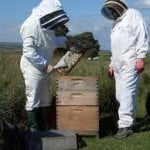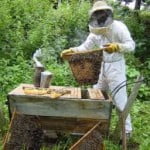Beekeeping Basics
Beekeeper Veil
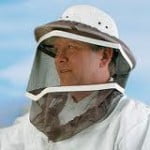
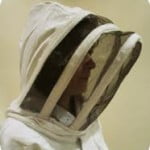 One of the basic pieces of equipment a beekeeper should have is a veil. While bee stings are relatively a rare occurrence, one of the last places anyone wants to get stung is in the eye. Also, having a bee caught in your hair is unsettling, so wearing a veil while inspecting hives is highly recommended.
One of the basic pieces of equipment a beekeeper should have is a veil. While bee stings are relatively a rare occurrence, one of the last places anyone wants to get stung is in the eye. Also, having a bee caught in your hair is unsettling, so wearing a veil while inspecting hives is highly recommended.
If you are crafty and already have a wide brimmed hat, you can make a veil with screening material. Otherwise bee supply catalogs sell the hat in the $16-18 price range and the veil costs between $15-20. some beekeepers prefer the hooded style veil which costs around $30.
Hive Tool
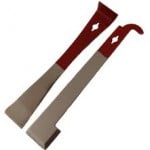 An inexpensive hive tool is one of the best investments a beekeeper can make. Hive tools can cost as little as $4. Many beekeepers keep one with each hive and others only have one hive tool on hand. Hive tools help a beekeeper open a hive stuck together with propolis and also help in removing frames, scraping excess wax and other hive tasks.
An inexpensive hive tool is one of the best investments a beekeeper can make. Hive tools can cost as little as $4. Many beekeepers keep one with each hive and others only have one hive tool on hand. Hive tools help a beekeeper open a hive stuck together with propolis and also help in removing frames, scraping excess wax and other hive tasks.
Smoker
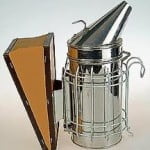 While beekeepers can perform a hive inspection many times without ever using a smoker, it is always wise to have one on hand for the times when it is needed. (I always light my smoker with every hive inspection, whether I end up needing it or not.) Smokers range from $20-40. Some have plastic bellows and some have wood/leather bellows. Bee supply houses sell smoker pellets or smoker fuel, but many beekeepers burn burlap, wood chips, pine needles or even dried cow dung that they find or have on hand for free.
While beekeepers can perform a hive inspection many times without ever using a smoker, it is always wise to have one on hand for the times when it is needed. (I always light my smoker with every hive inspection, whether I end up needing it or not.) Smokers range from $20-40. Some have plastic bellows and some have wood/leather bellows. Bee supply houses sell smoker pellets or smoker fuel, but many beekeepers burn burlap, wood chips, pine needles or even dried cow dung that they find or have on hand for free.
Wooden Hive Components
Commercial beekeepers use minimal equipment which is easier for them to stack and ship across the country when providing pollination services. Hobbyist beekeepers often rarely move their hives, so they utilize wooden components that help create a more hospitable environment for bees and a less friendly environment for bee pests. While you can choose to set up your hives any way you wish or are taught, the items listed here are what we recommend in our area.
Langstroth, Top Bar, or … ???
Two common hive styles are shown at left. The Langstroth hive is a vertical hive structure and the Top Bar style is set up in a horizontal fashion. Each have their benefits and drawbacks. We recommend you research and learn to discover which style is right for you.
Hive Stand
In the Sierra Nevada Foothills many of us country folk are accustomed to dealing with raccoons, skunks and bear. We will discuss dealing with bears in another section, but here a hive stand that keeps the bee hive at least 16″ off the ground is recommended. The extra height makes it more difficult for skunks and raccoons because they will need to stand on their hind legs to get to the bees. Also the hive stand keeps hives that much further off the ground during the winter when snow arrives. Beekeepers are very creative in the use of materials they find to build hive stands. Some use cement blocks, others metal stands and most build wooden hive stands. Plans can be found on the internet and plans for a hive stand are provided at our beginning beekeeping classes.
Screened Bottom Board
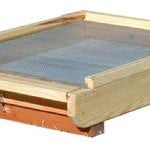 A screened bottom board not only provides a platform for the hive boxes, but it also is deep enough so that mites, who mite fall through the screened “floor” of the hive drop at least two inches further which is a little too far for them to climb back up to find a new host. Some beekeepers oil the observation tray that can be slipped out to insure they catch any pests, others may not. The observation tray at the very bottom of a screened bottom board can be inspected to discover the health of the hive without opening the hive itself. This is helpful during poor weather or during winter, and recommended at the beginning of any hive inspection to determine where the bees are working in the hive, if there have been any signs of robbing or infestation by wax moths. Screened bottom boards can be built by talented woodworkers or purchased. Prices range from $30-40.
A screened bottom board not only provides a platform for the hive boxes, but it also is deep enough so that mites, who mite fall through the screened “floor” of the hive drop at least two inches further which is a little too far for them to climb back up to find a new host. Some beekeepers oil the observation tray that can be slipped out to insure they catch any pests, others may not. The observation tray at the very bottom of a screened bottom board can be inspected to discover the health of the hive without opening the hive itself. This is helpful during poor weather or during winter, and recommended at the beginning of any hive inspection to determine where the bees are working in the hive, if there have been any signs of robbing or infestation by wax moths. Screened bottom boards can be built by talented woodworkers or purchased. Prices range from $30-40.
Hive Boxes
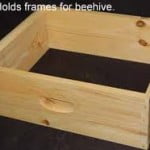 Hive boxes come in two widths to accept either 8 frames or more commonly 10 frames. For brood boxes either a 9 5/8″ (deep) or 6 5/8″ (medium) boxes are used. Make your decision based on ease of handling. These boxes can be very heavy when filled with bees and honey. Honey boxes are more typically medium boxes.
Hive boxes come in two widths to accept either 8 frames or more commonly 10 frames. For brood boxes either a 9 5/8″ (deep) or 6 5/8″ (medium) boxes are used. Make your decision based on ease of handling. These boxes can be very heavy when filled with bees and honey. Honey boxes are more typically medium boxes.
Frames and Foundation
Frames are wood with wax foundation or plastic foundation or integrated plastic frame and foundation. The choice is yours but it is best to stay with one style. Also, some beekeepers prefer to let the bees ‘build their own furniture”, providing no foundation in the frames. Talk to other beekeepers to decide what sounds best for you. If working with top bar hives there is by definition only a top bar.
Check back for more information later…..

